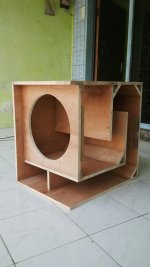I have a 22" fiberglass sphere that I would like to use as an enclosure for either a sub or a bass driver BUT as a transmission line. I have been trying to imagine the (internal) design problems that would come with this project. Since I have never built a TL but only modified a pre-exisiting one, I am having difficulties with the design of the internal chambers. Most TL cad programs are for boxes (of sorts) with at least 2 parallel walls.
Does anyone have any experience building a TL in a sphere? Any help would be appreciated.
Thanks in advance.
Does anyone have any experience building a TL in a sphere? Any help would be appreciated.
Thanks in advance.
That's not very large.
Design of TLs and labyrinths (my strong preference) are almost purely a matter of length. If you can make a long path (with adequate cross-section... no need to be too big), you can do it. Seems unlikely.
May I suggest a leaky sealed box. There won't be internal pressure on your sphere and you can just fill the insides with pillow stuffing and have an exit hole. Or you could think of it as a highly damped BR.
With a bigger hole, you can think of it as a dipole. Dipoles are really great sounding and the bass would work just fine and the driver's resonance would stay low and be active just where you want it to contribute, no kidding.
B.
Design of TLs and labyrinths (my strong preference) are almost purely a matter of length. If you can make a long path (with adequate cross-section... no need to be too big), you can do it. Seems unlikely.
May I suggest a leaky sealed box. There won't be internal pressure on your sphere and you can just fill the insides with pillow stuffing and have an exit hole. Or you could think of it as a highly damped BR.
With a bigger hole, you can think of it as a dipole. Dipoles are really great sounding and the bass would work just fine and the driver's resonance would stay low and be active just where you want it to contribute, no kidding.
B.
I would build the transmissionline as a series of rings made out of Styrofoam. Then I would cover these with glasfiber and West Epoxy 105 + 205. Once cured I would melt away the styrofoam with some acetone.
This way you have a great degree of freedom in designing your transmissionline within a spherical enclosure.
This way you have a great degree of freedom in designing your transmissionline within a spherical enclosure.
YouTube
Great proof of concept video of this methode.
Epoxy Resin and Hardeners - WEST SYSTEM Marine Grade Epoxy
Link to the West Epoxy product. Lots of great information on their website about epoxy and how to use it.
Great proof of concept video of this methode.
Epoxy Resin and Hardeners - WEST SYSTEM Marine Grade Epoxy
Link to the West Epoxy product. Lots of great information on their website about epoxy and how to use it.
Last edited:
That's not very large.
Design of TLs and labyrinths (my strong preference) are almost purely a matter of length. If you can make a long path (with adequate cross-section... no need to be too big), you can do it. Seems unlikely.
May I suggest a leaky sealed box. There won't be internal pressure on your sphere and you can just fill the insides with pillow stuffing and have an exit hole. Or you could think of it as a highly damped BR.
With a bigger hole, you can think of it as a dipole. Dipoles are really great sounding and the bass would work just fine and the driver's resonance would stay low and be active just where you want it to contribute, no kidding.
B.
Thanks fo your suggestion. Its interesting and I will think about it. It would certainly be easier to design.
However, I have been looking at these designs and I thought that I could do something similar to them but the enclosure would be a sphere. Unfortunately few who shoot their project rarely puts in their acoustic results. What do you think of them as designs?
I also thought about buying black drainage hoses (4-5" diameter) to fill the interior of the sphere. Possible??
Attachments
I would probably put a spiral path in it with flexible plywood, that starts at the outside with the driver and ends in the middle (exits on the sides). So from the side the schematic would look just like a cylinder.


